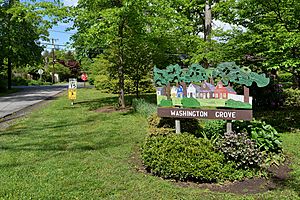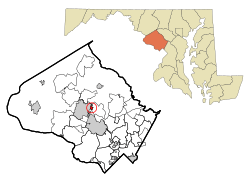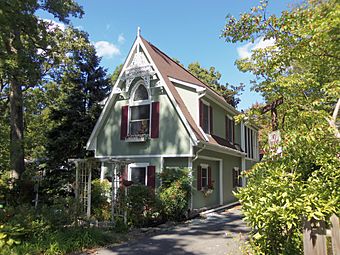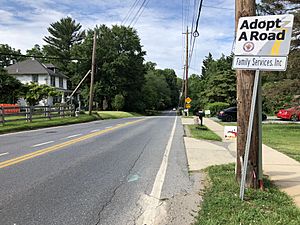Washington Grove, Maryland facts for kids
Quick facts for kids
Washington Grove, Maryland
|
||
|---|---|---|

The Washington Grove welcome sign
|
||
|
||
| Motto(s):
"A Town Within a Forest"
|
||

Location of Washington Grove in Montgomery County and Maryland
|
||
| Country | ||
| State | ||
| County | Montgomery | |
| Founded | July 29, 1874 | |
| Incorporated | March 26, 1937 | |
| Area | ||
| • Total | 0.34 sq mi (0.88 km2) | |
| • Land | 0.34 sq mi (0.87 km2) | |
| • Water | 0.00 sq mi (0.00 km2) | |
| Elevation | 525 ft (160 m) | |
| Population
(2020)
|
||
| • Total | 505 | |
| • Density | 1,502.98/sq mi (579.69/km2) | |
| Time zone | UTC-5 (Eastern (EST)) | |
| • Summer (DST) | UTC-4 (EDT) | |
| ZIP code |
20880
|
|
| Area code(s) | 301, 240 | |
| FIPS code | 24-81675 | |
| GNIS feature ID | 2391472 | |
|
Washington Grove Historic District
|
|

The Washington Grove Historic District in September 2012
|
|
| Location | Washington Grove, Maryland |
|---|---|
| Built | 1873 |
| Architectural style | Late Gothic Revival |
| NRHP reference No. | 80001829 (original) 100005640 (increase) |
| Significant dates | |
| Added to NRHP | April 9, 1980 |
| Boundary increase | September 28, 2020 |
Washington Grove is a small and unique town in Montgomery County, Maryland, United States. It's known for its beautiful natural setting, often called "A Town Within a Forest." In 2020, about 505 people lived here. The town is so special that its historic area, called the Washington Grove Historic District, was added to the National Register of Historic Places in 1980. This means it's recognized for its important history and unique design.
Contents
Discovering Washington Grove's Past
Washington Grove has a fascinating history that began with a special kind of religious gathering.
How Washington Grove Began
Around the 1800s, a religious group called Methodists started holding "camp meetings." These were outdoor worship events where people gathered in forest clearings. They would set up benches in a circle around a raised platform for preachers. Tents, carriages, and wagons surrounded the area. These meetings often lasted late into the night and helped people grow spiritually and culturally.
In 1873, a committee from the Foundry Methodist Church in Washington, D.C. started looking for a permanent place for their yearly camp meetings. They needed a large area for thousands of people, clean water, and plenty of shade to escape the summer sun. It also had to be close enough to Washington, D.C., for an easy day trip.
In June 1873, a group of people bought about 267.5 acres of land from a farmer's widow for $6,636.25. This land was then given to a new group called the Washington Grove Meeting Association. This was the start of what would become Washington Grove.
Life in the 1800s
To live in this new community, people could buy five shares of stock for $20 each to build a small cottage. The first share needed to be paid in cash, and the rest could be paid over time. If you didn't want to buy, you could rent a tent for $9 to $15. There were also two dining areas and a market for fresh food.
The center of the camp was first called The Plaza, then The Symbolic Circle. Six main roads spread out from it, and tents were set up in rows along smaller roads named after different churches. Families would stay for a two-week meeting of Methodist Episcopal churches. The very first camp meeting at Washington Grove Camp started on August 5, 1874, with 240 tents.
The Tabernacle and Community Rules
In 1877, a large, open-air chapel called a tabernacle was built in the center of the circle. It had a belfry with a bell that called people to prayer and marked the end of the camp meeting. The tabernacle could hold 500 worshipers. Besides religious services, people also gave talks on important topics like women's suffrage (the right for women to vote) and how to help people living in poverty.
The Maryland government gave the camp managers special power. They could control all land within two miles of the meeting site to stop businesses from opening too close. The managers used this power to ban alcohol sales on the grounds. While fun programs were allowed, card games, theater, and dancing were not. In 1879, they even voted to ban all sales on Sundays.
Early Cottages and Buildings
The first cottage was built in 1878 by Reverend William Burns. By 1879, seventeen cottages had been built. They all had green and white outsides, big porches, and peaked roofs that looked like the original tents. Their style was called Carpenter Gothic, which was popular then. A train ticket from Washington, D.C., to Washington Grove cost eighty cents in 1879.
In 1879, the leaders decided to borrow $4,000 to build a hotel. The hotel was finished in 1881. It had three stories in the middle, two stories on the sides, 23 sleeping rooms, a parlor, a dining room, and a kitchen. It was built for less than the planned budget. In 1889, they started building a chapel that could hold 800 people.
The Albany Hotel was built in 1881 by Wash Williams. It had large porches, a big dining room, a barber shop, and a small store. Rooms cost $6 to $7 per week, and dinner was fifty cents. Also in 1880, rules were made to protect the existing trees when new cottages and streets were built.
In 1905, a larger building called an auditorium was built in Woodward Park. It could seat 1,400 people and was used for musical programs, educational talks, and spelling bees. Religious services were also held there. As the auditorium became more important, the old Tabernacle was taken down.
Rules About Who Could Live There
Because the Washington Grove Camp Meeting Association owned the land, they decided who could buy or rent plots. In the early 1900s, the Association and later the Town of Washington Grove put special rules in property deeds. These rules were called "restrictive covenants" and were used to stop African Americans from buying, renting, or living in Washington Grove.
For example, a deed from 1925 said that because the death rate of African Americans was higher than white people, it would harm the town's health and property value. So, it prevented African Americans from owning or renting property there.
Near Washington Grove, there was another camp called Emory Grove, founded in 1864 by Black Methodists. Many people from Emory Grove worked in Washington Grove. After an incident in 1892, the superintendent from Emory Grove, William A. Scott, was forced to leave. In 1897, the gates to Washington Grove were closed, stopping people from walking through. This made it very hard for Emory Grove residents to reach the train station on the other side of Washington Grove.
Washington Grove in the 1900s
Over time, people started living in Washington Grove all year round. By 1910, the church formed a group that met throughout the year. In the 1920s, the Washington Grove Camp Meeting Association began selling parts of the land instead of just offering 99-year leases. By 1924, the camp meetings themselves were no longer held.
Changes and Challenges
The Great Depression in the 1930s greatly affected the area. The Washington Grove Camp Meeting Association struggled to pay its bills. They cut back on insurance and sometimes needed donations to pay for electricity. Some people could no longer afford their vacation homes, so some homes were rented out, and others were left empty.
By 1934, the Association realized the town had changed a lot since it started. Some residents wanted the area to become part of Gaithersburg. Committees met for several years to plan the community's future. In 1937, the Washington Grove Camp Meeting Association was officially ended. The Maryland government then made Washington Grove an official town on March 26, 1937.
Maryland Governor Harry Nice signed the town's official document on May 18, 1937. On July 10, 1937, the town held its first election. They chose their first mayor, Irving L. McCathran, and six town council members. McCathran served as mayor for twenty years.
By the late 1940s, Washington Grove looked a bit worn down. The Assembly Hall was in bad shape, the parks were messy, and many cottages were so old they had to be torn down. There wasn't enough money to keep up the Auditorium, so it was also taken down. Farms around Gaithersburg were being sold to developers, which changed the area and put pressure on Washington Grove to change too. In 1955, the Town of Washington Grove gained the power to control its own building and planning to protect its future.
In 1975, a "master plan" was written to help keep the town's historic look and feel. The town applied to be on the National Register of Historic Places in 1979, and it was approved the next year.
Washington Grove Today
The town has kept its original design in the center, with small houses facing grassy paths. Cars can only get to the back of these houses using paved streets. Newer houses don't face the paths but still fit the "Grove" style because they were built one by one in different designs, not all at once.
More than half of the town is owned by the public. The East Woods and West Woods are special areas for wildlife, making them the only forests owned by a town in Maryland. The many paths and parks are popular with both residents and people from nearby communities. On nice evenings, you can see people walking, strolling with dogs, and chatting.
Residents gather for musical picnics at the Gazebo, town meetings at McCathran Hall, and summer swimming at Maple Lake, the town's swimming spot in the West Woods. Other town activities include a summer program for children, a book club, a movie club, and the "Mousetrap" concert series.
In 2013, a group called Preservation Maryland listed Washington Grove as a historic property that needed protection.
Where is Washington Grove?
Washington Grove is located at 39°8′22″N 77°10′33″W / 39.13944°N 77.17583°W.
According to the United States Census Bureau, the town covers a total area of about 0.35 square miles (0.88 square kilometers), and all of it is land.
How Many People Live Here?
Here's how the population of Washington Grove has changed over the years:
| Historical population | |||
|---|---|---|---|
| Census | Pop. | %± | |
| 1940 | 160 | — | |
| 1950 | 400 | 150.0% | |
| 1960 | 576 | 44.0% | |
| 1970 | 688 | 19.4% | |
| 1980 | 527 | −23.4% | |
| 1990 | 434 | −17.6% | |
| 2000 | 515 | 18.7% | |
| 2010 | 555 | 7.8% | |
| 2020 | 505 | −9.0% | |
| U.S. Decennial Census | |||
Washington Grove's Population in 2010
The census of 2010 showed that 555 people lived in Washington Grove, in 230 households, with 157 of those being families. The population density was about 1,585.7 people per square mile. There were 242 housing units, with an average of 691.4 units per square mile.
Most residents (85.2%) were White, 4.0% were African American, and 7.4% were Asian. About 2.5% were from other races, and 0.9% were from two or more races. Hispanic or Latino people made up 5.6% of the population.
About 28.7% of households had children under 18. Most households (56.1%) were married couples living together. The average household had 2.41 people, and the average family had 2.87 people.
The average age in town was 49.7 years. About 20.5% of residents were under 18, and 13.3% were 65 or older. The town was almost evenly split between males (48.8%) and females (51.2%).
Learning in Washington Grove
The town is part of the Montgomery County Public Schools district.
The schools that serve Washington Grove include:
- Washington Grove Elementary School
- Forest Oak Middle School
- Gaithersburg High School
Getting Around Washington Grove
There are no major state highways that go directly through Washington Grove. The main road is Washington Grove Lane, which is maintained by the county. However, larger highways like Interstate 370, Interstate 270, and Maryland Route 200 are nearby.
The Washington Grove station is a train stop on MARC's Brunswick Line. This train service helps people travel to and from Washington D.C. for work or other activities.
Images for kids
See Also
 In Spanish: Washington Grove (Maryland) para niños
In Spanish: Washington Grove (Maryland) para niños





